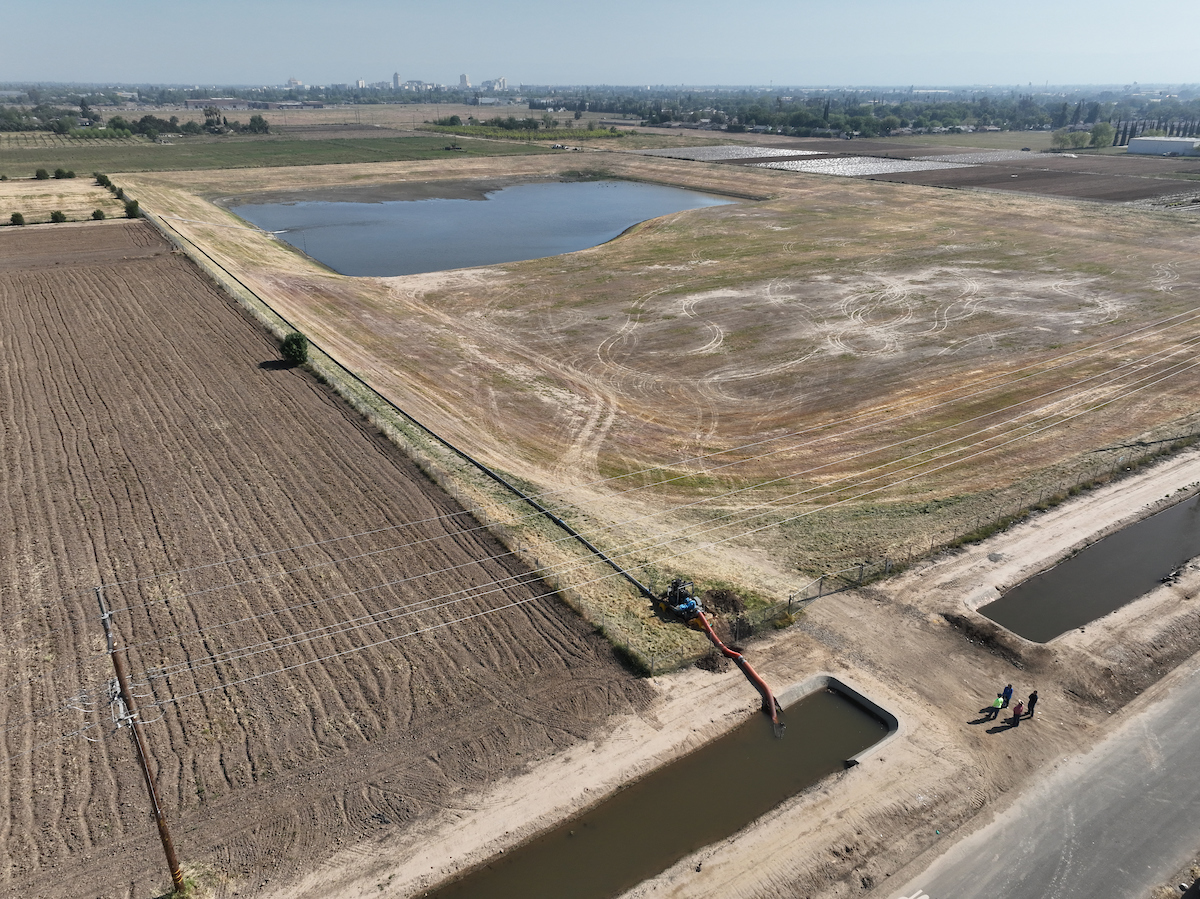Temporary diversion equipment provided by DWR is deployed by Fresno Irrigation District to divert excess water from Kings River to reduce flood risk and expand groundwater recharge. Photo taken April 27, 2023.
Sacramento, Calif. – The Department of Water Resources (DWR) is implementing an emergency program to divert high river flows away from flood-prone Central Valley communities and into groundwater recharge basins. DWR is working with local agencies and equipment vendors to provide funding and secure much-needed temporary diversion equipment, including pumps and siphons, and will support their deployment by local agencies.
The first set of temporary pumps and siphons were deployed by Fresno Irrigation District on April 25, as seen in this video. The district is reducing downstream flood impacts in the Tulare Lake Region and expanding groundwater recharge efforts by diverting water from Kings River reaches to existing recharge facilities or working agricultural lands.
Here's more information on how much water these pumps will divert:
- The pumps being deployed are equipped with flow meters and range in diversion capacity from 5 to 50 cubic-feet per second (cfs) of water from high-flow rivers. One cfs is equivalent to a basketball-sized quantity of water passing every second. A single pump operating at 5 cfs for 24 hours moves approximately 10 acre-feet of water per day.
- One acre-foot is about 326,000 gallons of water or the size of a football field with one foot of standing water. Most crops require roughly three acre-feet of water per year for every acre, and one acre-foot can supply nearly three households for an entire year.
- There are 15 temporary pumps currently in the planning and deployment phase in and around the Central Valley.
- Operating these pumps to divert water for the next four months could capture upwards of 55,000 acre-feet in spring runoff, alleviating flood impacts to communities and bolstering the amount of water stored underground.
“In times of emergency, it’s critically important that state and local agencies roll up our sleeves to coordinate and communicate what is needed,” said Paul Gosselin, DWR Deputy Director of Groundwater Management. “Based on feedback from local agencies, DWR acted quickly to secure this needed equipment so agencies could expand their capacity to divert high river flows and increase groundwater recharge.”
The state is maximizing opportunities to capture and divert water from this year’s record snowpack, providing multiple benefits – diverting high flows from rivers that would otherwise drain to the flood-prone Tulare Lake Basin, using recently fallowed or open and working lands, and pumping and spreading water to recharge historically depleted groundwater basins.
Expediting groundwater recharge is a key water resilience strategy of the Newsom Administration’s Water Supply Strategy: Adapting to a Hotter, Drier Future and is helping local agencies bring historically depleted aquifers into balance. The Governor’s Executive Orders (EO) N-4-23 and N-6-23 are streamlining flood diversions from these intense storms and spring runoff this year, while upholding habitat and wildlife protections. Many local agencies have been able to use the EO and so far, more than 90,000 acre-feet of waters have been diverted under the EO.
DWR’s Temporary Flood Diversion Equipment and Groundwater Recharge program and the actions by the Newsom Administration to support groundwater recharge are providing significant benefits towards protecting communities impacted by possible flooding and mitigating groundwater depletion over the past decades.
These kinds of state-local partnerships are key to developing innovative solutions to the challenges of a changing climate and building resiliency to protect the state’s water supplies and communities.
For more information, visit:
- Groundwater Recharge (ca.gov)
- Refilling-Californias-Underground-Reservoirs.pdf
- Governor's Executive Order N-4-23 For Flood Diversion | California State Water Resources Control Board
- Video – Temporary Pumps at Fresno Irrigation District
Contact:
Mary Fahey, Information Officer, Public Affairs, Department of Water Resources
916-820-8083 | media@water.ca.gov
